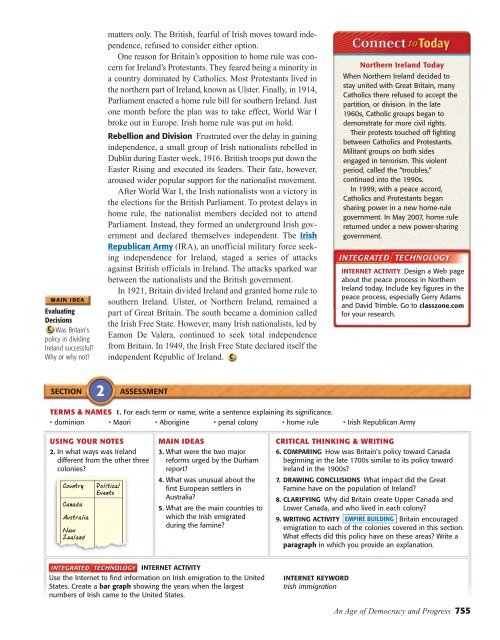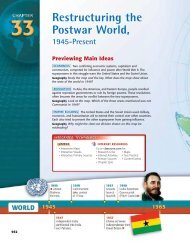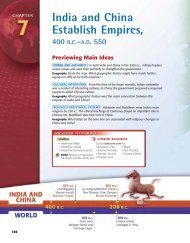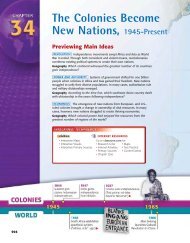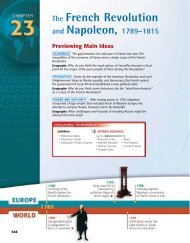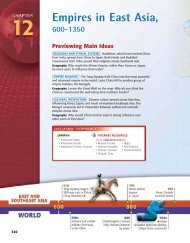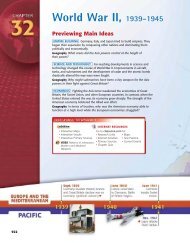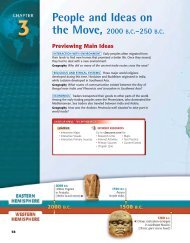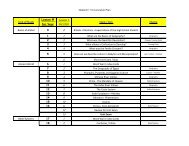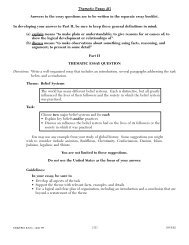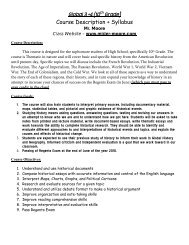The Industrial Revolution, 1700– 1900 Previewing Main Ideas
The Industrial Revolution, 1700– 1900 Previewing Main Ideas
The Industrial Revolution, 1700– 1900 Previewing Main Ideas
Create successful ePaper yourself
Turn your PDF publications into a flip-book with our unique Google optimized e-Paper software.
Evaluating<br />
Decisions<br />
Was Britain’s<br />
policy in dividing<br />
Ireland successful?<br />
Why or why not?<br />
matters only. <strong>The</strong> British, fearful of Irish moves toward independence,<br />
refused to consider either option.<br />
One reason for Britain’s opposition to home rule was concern<br />
for Ireland’s Protestants. <strong>The</strong>y feared being a minority in<br />
a country dominated by Catholics. Most Protestants lived in<br />
the northern part of Ireland, known as Ulster. Finally, in 1914,<br />
Parliament enacted a home rule bill for southern Ireland. Just<br />
one month before the plan was to take effect, World War I<br />
broke out in Europe. Irish home rule was put on hold.<br />
Rebellion and Division Frustrated over the delay in gaining<br />
independence, a small group of Irish nationalists rebelled in<br />
Dublin during Easter week, 1916. British troops put down the<br />
Easter Rising and executed its leaders. <strong>The</strong>ir fate, however,<br />
aroused wider popular support for the nationalist movement.<br />
After World War I, the Irish nationalists won a victory in<br />
the elections for the British Parliament. To protest delays in<br />
home rule, the nationalist members decided not to attend<br />
Parliament. Instead, they formed an underground Irish government<br />
and declared themselves independent. <strong>The</strong> Irish<br />
Republican Army (IRA), an unofficial military force seeking<br />
independence for Ireland, staged a series of attacks<br />
against British officials in Ireland. <strong>The</strong> attacks sparked war<br />
between the nationalists and the British government.<br />
In 1921, Britain divided Ireland and granted home rule to<br />
southern Ireland. Ulster, or Northern Ireland, remained a<br />
part of Great Britain. <strong>The</strong> south became a dominion called<br />
the Irish Free State. However, many Irish nationalists, led by<br />
Eamon De Valera, continued to seek total independence<br />
from Britain. In 1949, the Irish Free State declared itself the<br />
independent Republic of Ireland.<br />
SECTION 2 ASSESSMENT<br />
TERMS & NAMES 1. For each term or name, write a sentence explaining its significance.<br />
• dominion • Maori • Aborigine • penal colony • home rule • Irish Republican Army<br />
USING YOUR NOTES<br />
2. In what ways was Ireland<br />
different from the other three<br />
colonies?<br />
Country Political<br />
Events<br />
Canada<br />
Australia<br />
New<br />
Zealand<br />
MAIN IDEAS<br />
3. What were the two major<br />
reforms urged by the Durham<br />
report?<br />
4. What was unusual about the<br />
first European settlers in<br />
Australia?<br />
5. What are the main countries to<br />
which the Irish emigrated<br />
during the famine?<br />
INTERNET ACTIVITY<br />
Use the Internet to find information on Irish emigration to the United<br />
States. Create a bar graph showing the years when the largest<br />
numbers of Irish came to the United States.<br />
Northern Ireland Today<br />
When Northern Ireland decided to<br />
stay united with Great Britain, many<br />
Catholics there refused to accept the<br />
partition, or division. In the late<br />
1960s, Catholic groups began to<br />
demonstrate for more civil rights.<br />
<strong>The</strong>ir protests touched off fighting<br />
between Catholics and Protestants.<br />
Militant groups on both sides<br />
engaged in terrorism. This violent<br />
period, called the “troubles,”<br />
continued into the 1990s.<br />
In 1999, with a peace accord,<br />
Catholics and Protestants began<br />
sharing power in a new home-rule<br />
government. In May 2007, home rule<br />
returned under a new power-sharing<br />
government.<br />
INTERNET ACTIVITY Design a Web page<br />
about the peace process in Northern<br />
Ireland today. Include key figures in the<br />
peace process, especially Gerry Adams<br />
and David Trimble. Go to classzone.com<br />
for your research.<br />
CRITICAL THINKING & WRITING<br />
6. COMPARING How was Britain’s policy toward Canada<br />
beginning in the late 1700s similar to its policy toward<br />
Ireland in the <strong>1900</strong>s?<br />
7. DRAWING CONCLUSIONS What impact did the Great<br />
Famine have on the population of Ireland?<br />
8. CLARIFYING Why did Britain create Upper Canada and<br />
Lower Canada, and who lived in each colony?<br />
9. WRITING ACTIVITY EMPIRE BUILDING Britain encouraged<br />
emigration to each of the colonies covered in this section.<br />
What effects did this policy have on these areas? Write a<br />
paragraph in which you provide an explanation.<br />
INTERNET KEYWORD<br />
Irish immigration<br />
An Age of Democracy and Progress 755


